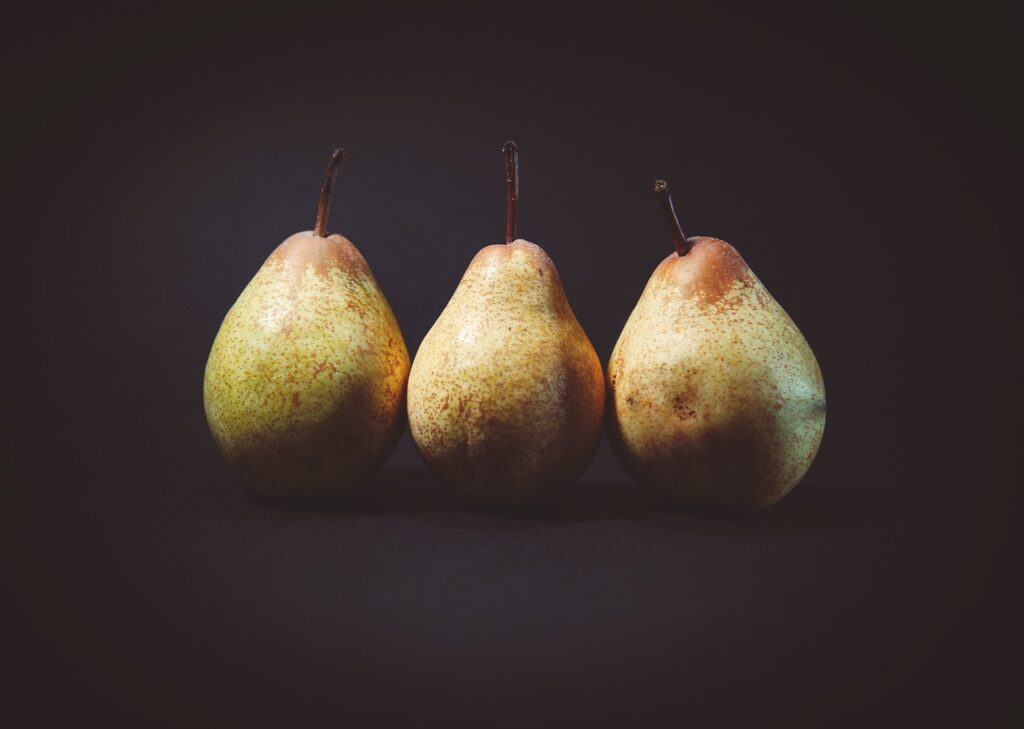Have you ever bitten into a pear that’s perfectly sweet, juicy, and soft? Pears are a delicious and versatile fruit—but only when they’re ripe. Since most pears are picked before they reach peak ripeness, learning how to ripen pears naturally at home is the key to enjoying their full flavor. In this guide, we’ll show you simple and proven ways to get perfectly ripe pears every time.
Pears are a flavorful and versatile fruit that can be enjoyed in many ways—from snacking fresh to using them in desserts, salads, and even savory dishes. However, their true flavor only shines when they’re perfectly ripe. In any case, to genuinely relish their sweet, delicious goodness, knowing when and how to properly ripen pears is essential. Therefore, we will investigate the best techniques for ripening pears, when they are in season, how to store, freeze, and conclude for certain practical tips. Let’s dive in

Have you ever thought of learning how to Ripen Pears? It is a delicate process that requires patience and careful monitoring. Pears are often harvested before they reach their peak ripeness to prevent bruising during transportation. To know how to ripen pears at home, follow these steps:
Table of Contents
How to Ripen Pears
Ripen Pears at Home
Choose the Right Pear
Start by selecting pears that are firm and unblemished. The most common varieties for ripening at home include Bartlett, Bosc, Anjou, and Comice.
- Bartlett: Fast-ripening and ideal for fresh eating.
- Bosc: Firm and sweet, great for baking.
- Anjou: Versatile with slow ripening.
- Comice: Juicy and dessert-worthy.
Check for Ripeness
To determine if a pear is ready to ripen, gently press your thumb near the stem’s base. If it yields slightly to pressure, it’s ready. Avoid squeezing the fruit too hard, as it can cause bruising.
Store at Room Temperature:
Place the unripe pears in a single layer on a countertop or a fruit bowl at room temperature. Keep them away from direct sunlight and heat sources.
Use a Paper Bag:
If you want to expedite the ripening process, put the pears in a paper bag with a ripe banana or apple. These fruits release ethylene gas, a natural ripening agent, which will help ripen the pears faster.
Check the Pears Daily:
Check the pears daily for ripeness. Once they are soft and fragrant at the stem end, they are ready to eat. This can take anywhere from 2 to 5 days.
How to Ripen Pears at Room Temperature
most natural way to ripen pears is to leave them on the kitchen counter at room temperature (65°F to 75°F). Simply:
- Arrange the pears in a single layer.
- Avoid stacking to prevent bruising.
- Let them sit undisturbed for 3 to 7 days.
This method works best if you’re not in a hurry. Check them daily by gently pressing near the stem. Once they yield slightly, they’re ready to eat.
Ripen Pears in Minutes
While you can’t truly ripen a pear in minutes, you can soften it temporarily:
- Microwave a pear for 15–20 seconds (prick with a fork to avoid bursting).
- Let it cool slightly before eating.
This method is helpful if you’re in a rush, but be warned: it may slightly alter taste and texture. It’s not a replacement for natural ripening.
Ripen Pears in a Warm Spot
Pears ripen faster in warm environments. If your kitchen is cool, place the pears near a sunny window or on top of the refrigerator (but away from direct sunlight). The extra warmth will help ethylene gas accumulate and soften the pears faster.
When are Pears in Season
Pears have a distinct seasonality that varies depending on the variety. Here’s a general guideline for when different pear varieties are in season:
- Bartlett Pears: These juicy, sweet pears are typically in season from late summer to early fall, usually from August to September.
- Bosc Pears: Known for their firm texture and earthy flavor, Bosc pears are in season from late fall to early winter, spanning from October to January.
- Anjou Pears: Anjou pears are available for most of the year, with their peak season from late summer through early spring, from September to April.
- Comice Pears: These exceptionally sweet and tender pears are typically in season from late fall to winter, around November to January.

Signs of a Perfectly Ripe Pear
Use the “Check the Neck” technique:
- Gently press near the stem (neck) with your thumb.
- If it yields slightly, the pear is ripe.
- If the flesh is very soft or there are brown spots, it may be overripe.
Each variety ripens differently:
- Bartlett pears change from green to yellow.
- Anjou and Bosc pears retain their color even when ripe.
When Are Pears Ripe
The ripeness of pears depends on the variety and how you intend to use them. I am providing you with a quick guide to pear ripeness:
- Eating Fresh: Pears are best for fresh eating when they are slightly soft near the stem but still firm around the middle. The texture should be smooth, not mushy.
- Cooking: For recipes like pies or poached pears, you’ll want them to be firmer, just before they reach full ripeness.
- Canning or Preserving: If you plan to can or preserve pears, choose firmer, slightly underripe ones for the best results.
What Not to Do When Ripening Pears
- Don’t use plastic bags: They trap moisture and cause mold.
- Avoid stacking: Pears bruise easily.
- Don’t refrigerate unripe pears: It halts the ripening process.
Nutritional Benefits of Pears
Pears are not just tasty—they’re packed with nutrients. One medium pear contains:
- About 100 calories
- 6 grams of fiber
- Vitamin C, K, and potassium
They’re also rich in antioxidants and great for digestive health, making them a perfect snack for all ages.
How to Store Pears
Once you know how to ripen pears the next important step is storing them. Proper storage is crucial to prolong the shelf life of ripe pears and prevent them from overripening too quickly. Follow these storage tips:

- Refrigeration: Ripe pears should be stored in the refrigerator to slow down the ripening process. Place them in a plastic bag to retain moisture.
- Separate from Ethylene Producers: Keep pears away from fruits that emit ethylene gas, such as apples and bananas, as this can speed up ripening.
- Use the Crisper Drawer: Store pears in the crisper drawer, where humidity levels are higher and more suitable for preserving their freshness.
- Check Regularly: Check your stored pears regularly to avoid spoilage. Consume them promptly to enjoy their peak flavor.
How to Freeze Pears
Freezing pears is an excellent way to enjoy their flavor and nutritional benefits year-round. Here’s how to freeze pears:
- Choose Ripe Pears: Select ripe pears, as freezing will not ripen them further.
- Prepare Pears: Wash, peel, and core the pears. Cut them into slices or cubes, removing any brown spots.
- Blanch: To preserve the pears’ color and texture, blanch them in boiling water for 1-2 minutes, then immediately transfer to an ice bath to cool.
- Drain and Pack: Drain the blanched pears and pack them into airtight containers or freezer bags, leaving some room for expansion.
- Label and Freeze: Label the containers with the date and place them in the freezer. Frozen pears can last for up to 10-12 months.
Conclusion
Learning how to ripen pears and enjoy them at their best is a rewarding experience. By following the steps outlined in this guide, you can ensure that your pears are perfectly ripe and ready to be savored. Remember to choose the right pear variety, check their ripeness, and store them properly to prolong their freshness. Additionally, freezing pears allows you to enjoy their delightful flavor year-round. So, whether you prefer them fresh or incorporated into your favorite dishes, pears are a delicious and nutritious addition to your culinary repertoire.
“Once you’ve learned how to ripen pears, check out our ‘ 32 irresistible pear recipes ‘for delicious ways to use them.”
FAQs (Q & A)
Can I ripen pears in the refrigerator?
While you can store ripe pears in the refrigerator to extend their freshness, it’s best to ripen them at room temperature. Refrigeration can slow down the ripening process.
Can I eat pears when they are slightly underripe?
Yes, pears can be enjoyed when slightly underripe, especially if you prefer a firmer texture. They are also suitable for cooking and baking in this state.
What’s the best way to use overripe pears?
Overripe pears can be used for making jams, jellies, smoothies, or even as a natural sweetener in baked goods. Their sweetness intensifies as they ripen further.
Are pear peels edible?
Yes, pear peels are edible and contain valuable nutrients and fiber. However, some people prefer to peel pears for certain recipes or personal preference.
How can I ripen pears overnight?
Use the paper bag + banana method in a warm spot. It’s your best bet for overnight ripening.
Can pears ripen after being refrigerated?
Yes, pears can continue to ripen after refrigeration, but the process slows down significantly in cold temperatures. To restart ripening, take them out of the fridge and leave them at room temperature for a day or two. Placing them in a paper bag with a ripe banana or apple can speed up the process.
How can I tell if a pear is ripe and ready to eat?
A ripe pear will give slightly when gently pressed near the stem — this is called the “check the neck” test. It should also have a sweet aroma and a slight softness. Avoid pears that feel mushy or have brown, sunken spots as they may be overripe.
